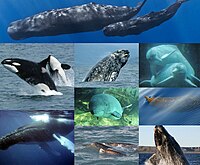
Photo from wikipedia
To navigate their surroundings, cells rely on sensory input that is corrupted by noise. In cells performing chemotaxis, such noise arises from the stochastic binding of signalling molecules at low… Click to show full abstract
To navigate their surroundings, cells rely on sensory input that is corrupted by noise. In cells performing chemotaxis, such noise arises from the stochastic binding of signalling molecules at low chemoattractant concentrations. We reveal a fundamental relationship between the speed of chemotactic steering and the strength of directional fluctuations that result from the amplification of noise in a chemical input signal. This relation implies a trade-off between steering that is slow and reliable, and steering that is fast but less reliable. We show that dynamic switching between these two modes of steering can substantially increase the probability to find a target, such as an egg to be found by sperm cells. This decision making confers no advantage in the absence of noise, but is beneficial when chemical signals are detectable, yet characterized by low signal-to-noise ratios. The latter applies at intermediate distances from a target, where signalling molecules are diluted, thus defining a ‘noise zone’ that cells have to cross. Our results explain decision making observed in recent experiments on sea urchin sperm chemotaxis. More generally, our theory demonstrates how decision making enables chemotactic agents to cope with high levels of noise in gradient sensing by dynamically adjusting the persistence length of a biased random walk.
Journal Title: PLoS Computational Biology
Year Published: 2018
Link to full text (if available)
Share on Social Media: Sign Up to like & get
recommendations!